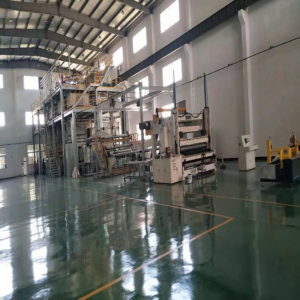Melt blown nonwoven fabric machines are used to produce melt blown nonwoven fabric, which is a specialized type of nonwoven fabric that is commonly used in filtration applications, such as air and liquid filters.
Here is some information about melt blown nonwoven fabric machines:
Process: Melt blown nonwoven fabric is produced by melting and extruding thermoplastic polymers through a set of spinneret nozzles. The extruded filaments are then blown by high velocity hot air, which separates and stretches the filaments, creating a fine mesh-like structure. The resulting fabric has a high degree of filtration efficiency and is commonly used in medical masks, air filters, and oil-absorbent materials.
Components: Melt blown nonwoven fabric machines typically include a feeding system, extruder, spinneret, hot air blowing system, and winding system. The feeding system is used to feed the raw material into the extruder, which melts the material and extrudes it through the spinneret. The hot air blowing system is used to blow the extruded filaments, while the winding system is used to wind the finished fabric onto a roll.
Raw materials: Melt blown nonwoven fabric is typically produced using thermoplastic polymers, such as polypropylene, polyester, or nylon. The quality of the raw materials can have a significant impact on the quality of the resulting fabric.
Production capacity: The production capacity of melt blown nonwoven fabric machines varies depending on the size and configuration of the machine. Small machines may have a production capacity of several hundred kilograms per day, while larger machines can produce several tons of fabric per day.
Maintenance: Regular maintenance is essential to keep melt blown nonwoven fabric machines operating efficiently and to ensure the quality of the resulting fabric. Maintenance tasks may include cleaning, lubrication, and inspection of critical components, such as the spinneret and extruder.
Overall, melt blown nonwoven fabric machines are specialized machines that are used to produce high-quality nonwoven fabric for filtration applications. By using the right raw materials, maintaining the machine properly, and ensuring proper operation, manufacturers can produce high-quality melt blown nonwoven fabric efficiently and effectively.
The most common types of thermoplastic polymers used in melt blown nonwoven fabric machines are polypropylene, polyester, and nylon.
Here is some information about each of these polymers:
Polypropylene: Polypropylene is a thermoplastic polymer that is widely used in melt blown nonwoven fabric machines. melt blown nonwoven fabric machine It is a lightweight, flexible, and durable material that is resistant to moisture, chemicals, and abrasion. Polypropylene melt blown nonwoven fabrics are commonly used in medical masks, air filters, and oil-absorbent materials.
Polyester: Polyester is another thermoplastic polymer that is commonly used in melt blown nonwoven fabric machines. It is a strong and durable material that is resistant to heat, chemicals, and UV radiation. Polyester melt blown nonwoven fabrics are commonly used in air filters, automotive filters, and protective clothing.
Nylon: Nylon is a thermoplastic polymer that is known for its strength and durability. It is a flexible and lightweight material that is resistant to abrasion and chemicals. Nylon melt blown nonwoven fabrics are commonly used in air filters, automotive filters, and industrial applications.
Overall, polypropylene, polyester, and nylon are the most common types of thermoplastic polymers used in melt blown nonwoven fabric machines. The choice of polymer will depend on the specific application and the desired properties of the final product.
